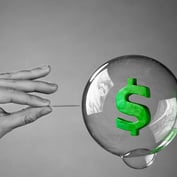Jim Paulsen, chief investment strategist at The Leuthold Group, notes the first 22 days of this bear market declined 6.5 times faster than all post-war bear markets, dropping 32 percent in 22 days versus an average of just down 5.1 percent for the previous bear markets.
What makes this bear market so unnerving is that its roots are in a public health crisis, shutting down the economy to battle coronavirus, rather than the typical factors behind economic slowdowns.
But bear markets, and market crashes, do end. In a statistical lookback, Sam Stovall, chief investment strategist at CFRA Research, notes from December 31, 1945, through the first quarter 2020, there were nine “garden variety” bear markets with an average of 2 percent losses from peak to trough and took 14 months to recover. The three “mega meltdown” bear markets, which he defines as more than 40 percent drops, had an average peak-to-trough loss of 51 percent. They took 23 months to decline and 58 months to recover.
Commonalities Among Market Crashes
Market crashes, like the current one, have individual triggers, but they also have commonalities, says Scott Nations, author of “A History of the United States in Five Crashes: Stock Market Meltdowns That Defined a Nation.” He studied five market crashes for his book: 1907, 1929, 1987, 2008 and the 2010 “flash crash.” He says looking back at those crashes can put the current crash in context.
“All the crashes were shockingly similar, even though there’s more than 100 years from the first one to the last one I talked about,” Nations says.
Similarity number one between then and now: They all had some sort of external non-financial catalyst, he says. In 1907, it was the San Francisco earthquake, absorbing all of the U.S.’s liquidity to rebuild the city, which was the most important financial center in the western half of the U.S. The 1987 crash was triggered by worries over a potential war with Iran after the country attacked U.S.-flagged oil tankers and the U.S. retaliated.
The magnitude of 2020’s crash is also similar to other crashes. Although 2008’s crash from peak-to-trough was more than 50 percent, the 1907 and 1987 drops were about 36 percent from their respective peaks. That’s close to 2020’s decline, when measured from the highs. All five crashes occurred when markets were at or near all-time highs, just as the current market was at the end of 2019.
Nations says 1929 is an outlier to the rest because the Federal Reserve and the federal government bungled the response. The model for Fed action is what Chairman Alan Greenspan did in 1987.
“Greenspan issued a terse, 30-word statement which essentially said, ‘We have all the money in the world. We’ll give it to you if you need it. So, banks, don’t cut off your customers,’” Nations says, which is why the 1987 crash didn’t affect the economy, and in 2008, the Fed’s actions and government programs helped stem the fallout from market crash.
Examining Technical Charts
Andrew Thrasher, chartered market technician and portfolio manager at Financial Enhancement Group, says the 2020’s extreme drop is comparable to plunges in 1929, 1987, 1998 and 2008. Even though stocks rebounded in April, he expects another test.
“When we’ve seen this many stocks fall below their 200-day moving average, it’s been extremely rare for the market to bounce back without forming some kind of complex bottom, meaning a consolidation or a test of the initial low,” he says.
To get a feel for bottoming action, he is watching for a decline in overall volatility, not just for the Volatility Index (VIX). He wants to see individual stock hit new 20-day highs and trade above their respective 50-day and 200-day moving averages with greater investor participation. That would “signal a sign of internal strength of the market and not just whipsaw swings of the broad indices,” Thrasher says.
He is also watching for offensive sectors, such as financials and technology, and value stocks, show strength. “Historically, value begins to outperform growth stocks coming out of most bear markets as well as offensive sectors … as traders begin to increase their risk appetite,” he says.
Comparisons to 1919 Flu Pandemic Difficult to Make
Nations says investors who look at stock market action during the 1919 flu pandemic won’t get many clues because markets were also affected by World War I ending.
However, a preliminary study published in April in a non-peer reviewed paper by Guido Baltussen and Pim van Vliet, both of Robeco Institutional Asset Management, reviewed the performance of equity styles, such as low volatility and high dividend, during the period around the 1919 flu pandemic and other deep historical market corrections.
Their paper notes that epidemics and pandemics historically have caused short-term equity market corrections, such as SARS and the Hong Kong flu. Looking back at the different equity styles during other market corrections in the pre-1926 period, including panics in 1873, 1884, 1893, 1903 and 1907, stocks fell by 20 to 25 percent.
“During these periods, we see the pattern emerging of low volatility and momentum offering protection, similar to March 2020. Interestingly, during the recoveries that followed (the timing of which is, by the way, generally hard to predict) small caps and high dividend outperformed,” Baltussen and van Vliet wrote, also saying more research will be needed.
What makes the current crash so unnerving is that even though the Fed and the federal government’s stimulus response is appropriate, they can only do so much to help the market rebound, Nations says. “We have to have good news on the clinical front,” he notes.
Although markets are jittery now, the worse mistake that investors can make right now is to decide to quit investing, Nation says. “The biggest lesson we should learn is that the stock market is resilient.”








 May 11, 2020 at 09:41 AM
May 11, 2020 at 09:41 AM







